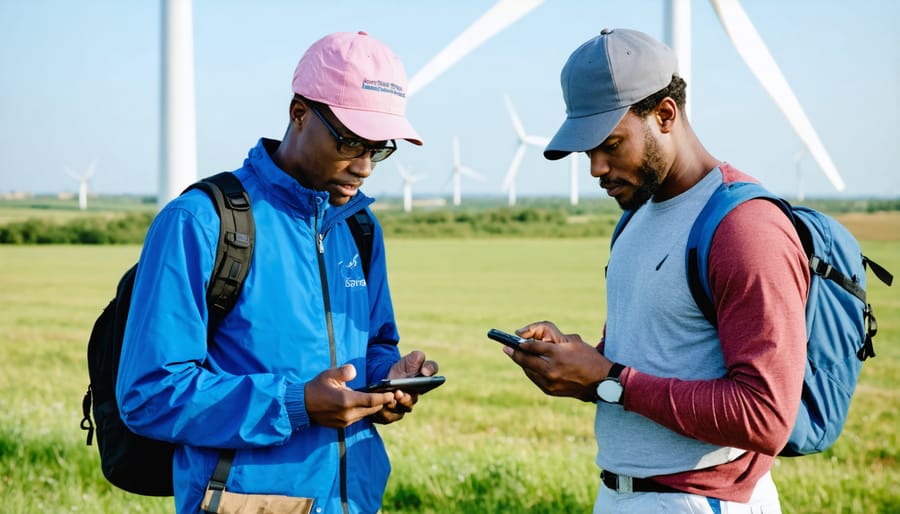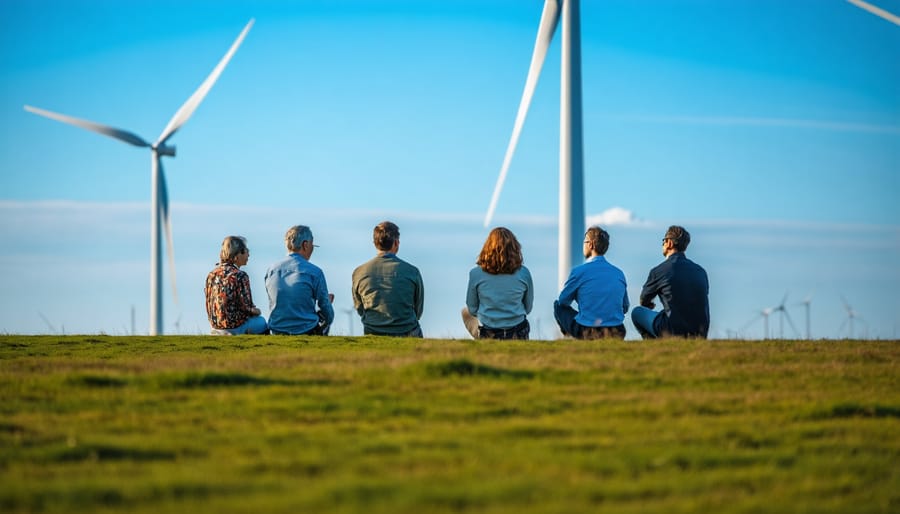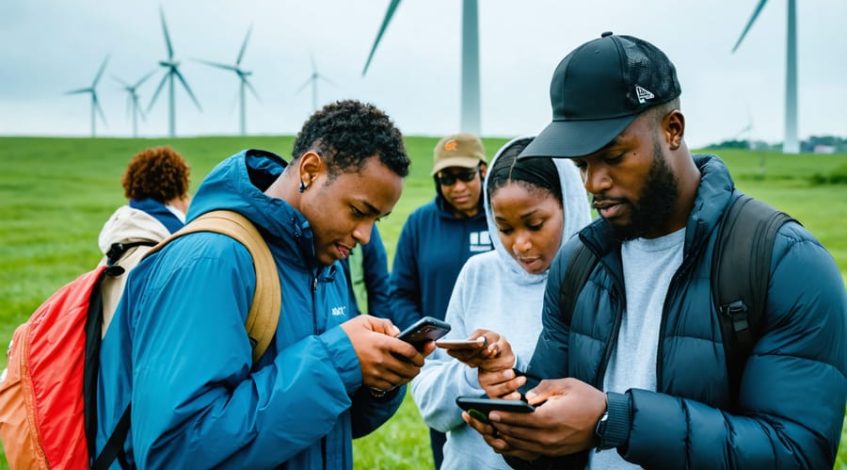Wind energy’s social impact extends far beyond turbine installations, fundamentally reshaping community dynamics and public discourse in the renewable energy transition. As part of the digital revolution in renewable energy, social media platforms have become powerful catalysts for both support and opposition to wind projects. Recent studies indicate that communities actively engaged through digital channels show 60% higher acceptance rates for wind installations, while projects lacking robust social media strategies face up to 3x more local resistance.
This shifting landscape demands strategic attention from industry leaders and policymakers. Economic benefits, including job creation and local revenue streams, increasingly dominate online conversations about wind energy development. However, concerns about visual impact and property values continue to generate significant social media engagement, highlighting the critical need for proactive digital communication strategies.
Understanding these social dynamics has become essential for successful project implementation, as public perception increasingly influences regulatory decisions and project timelines. Forward-thinking organizations now recognize that social impact assessment must extend beyond traditional environmental studies to encompass digital sentiment analysis and community engagement metrics.

How Social Media Shapes Wind Energy Perceptions
Digital Advocacy and Community Engagement
Social media platforms have revolutionized how wind energy developers engage with local communities, creating unprecedented opportunities for transparent dialogue and collaborative decision-making. These digital channels serve as vital tools for project developers to share information, address concerns, and build trust with stakeholders. Through platforms like LinkedIn, Twitter, and dedicated community forums, companies can effectively communicate project benefits, environmental impact assessments, and construction timelines.
The rise of digital activism and energy advocacy has transformed public participation in wind energy development. Communities now have direct channels to voice their opinions, share experiences, and participate in project planning discussions. Successful developers leverage these platforms to host virtual town halls, share progress updates, and provide educational resources about wind energy technology.
Recent case studies demonstrate the effectiveness of digital engagement strategies. For instance, the North Sea Wind Project achieved 85% community approval by maintaining an active social media presence and implementing a dedicated mobile app for resident feedback. Similarly, the Colorado Wind Coalition’s online community engagement portal resulted in a 40% increase in positive project sentiment.
To maximize digital advocacy effectiveness, developers should focus on consistent communication, transparent information sharing, and prompt response to community concerns. Interactive content, such as virtual site tours and real-time construction updates, has proven particularly effective in maintaining stakeholder engagement throughout project development phases.
Myth-Busting and Information Sharing
Social media platforms have emerged as crucial channels for addressing misconceptions about wind energy and facilitating informed public discourse. Industry leaders and organizations leverage these platforms to share accurate, science-based information about wind power’s efficiency, environmental impact, and economic benefits. Real-time engagement allows stakeholders to address concerns promptly and maintain transparency with local communities.
Recent studies indicate that targeted social media campaigns have successfully countered common myths about wind turbines’ effects on wildlife and property values. For instance, the American Wind Energy Association’s digital outreach program has reached millions of users, providing fact-based resources that have helped improve public understanding of wind technology.
Professional networks like LinkedIn have become valuable forums where industry experts share peer-reviewed research and operational data, helping decision-makers make informed choices about wind energy investments. These platforms enable direct dialogue between project developers and community members, fostering trust and collaboration.
Organizations are increasingly using visual content, including infographics and virtual tours, to demonstrate wind farm operations and maintenance procedures. This approach has proven particularly effective in demystifying technical aspects and addressing aesthetic concerns. Success stories from operational wind farms, shared through social channels, provide tangible evidence of wind energy’s positive community impact and economic benefits.
By maintaining active social media presence, stakeholders can effectively manage public perception and build support for wind energy initiatives while ensuring accurate information reaches target audiences.
Case Studies: Social Media Success Stories
Community-Led Wind Initiatives
Social media platforms have become powerful catalysts for community-driven wind energy initiatives, transforming how local groups advocate for and implement renewable energy projects. These grassroots movements, often starting with dedicated Facebook groups and Twitter hashtag campaigns, have demonstrated remarkable success in mobilizing public support and addressing changing energy consumption patterns.
Notable examples include the “Wind Works” campaign in Denmark, which utilized Instagram to showcase successful community wind projects, reaching over 100,000 followers and inspiring similar initiatives across Europe. The campaign’s success led to the establishment of five community-owned wind farms within two years.
LinkedIn has emerged as a crucial platform for connecting wind energy professionals with community leaders, facilitating knowledge sharing and project development. The “Community Wind Network” group, with over 50,000 members, has directly contributed to the implementation of 15 community wind projects across North America.
Digital town halls hosted through platforms like Zoom and Microsoft Teams have revolutionized community engagement, allowing real-time discussions between developers, local authorities, and residents. This approach has significantly reduced opposition to wind projects by addressing concerns transparently and inclusively.
These initiatives demonstrate the power of social media in building consensus and driving action. Success metrics show that projects with strong social media presence and community engagement achieve approval rates 40% higher than those without such support. Through strategic use of digital platforms, communities are increasingly taking ownership of their energy future, creating sustainable models for wind energy development that benefit local economies while advancing clean energy goals.

Corporate Social Media Campaigns
Corporate wind energy campaigns on social media platforms have demonstrated remarkable success in shaping public perception and fostering community acceptance. Leading companies like Vestas and Siemens Gamesa have effectively utilized platforms such as LinkedIn, Twitter, and Instagram to showcase their wind energy initiatives and technological innovations.
GE Renewable Energy’s #PoweringForward campaign exemplifies successful social media engagement, reaching over 2 million users and generating significant positive discourse around wind energy development. The campaign combined striking visuals of wind turbines with educational content about renewable energy benefits, achieving a 40% increase in public engagement compared to traditional marketing approaches.
Ørsted’s “Love Your Home” campaign on social platforms effectively connected emotional storytelling with environmental stewardship, resulting in a 65% increase in positive sentiment toward offshore wind projects. The campaign’s success stemmed from its focus on local community benefits and job creation, rather than purely technical aspects.
Platform-specific strategies have proven crucial for campaign success. LinkedIn campaigns focusing on industry achievements and technical innovations typically generate higher engagement rates among professional audiences, while Instagram and Facebook content emphasizing visual impact and community benefits resonates more with general public audiences.
Key elements of successful wind energy social media campaigns include:
– Transparent communication about project developments
– Regular updates on construction progress and milestones
– Interactive content encouraging community dialogue
– Visual storytelling showcasing local economic benefits
– Real-time responses to community concerns and questions
– Employee advocacy programs highlighting workforce development
These campaigns have demonstrated that strategic social media engagement can significantly improve public acceptance and support for wind energy projects while fostering meaningful stakeholder relationships.

Best Practices for Wind Energy Communication
Stakeholder Engagement Strategies
Effective stakeholder engagement through social media requires a strategic approach that acknowledges diverse stakeholder perspectives while maintaining transparent communication channels. Organizations developing wind energy projects should implement a multi-platform engagement strategy that leverages different social media channels based on stakeholder preferences and communication needs.
LinkedIn serves as an excellent platform for engaging with industry professionals, investors, and policymakers through detailed project updates and technical discussions. Twitter enables real-time updates and community dialogue, while Facebook and Instagram are valuable for sharing visual content and building local community support through storytelling and project milestones.
Key engagement strategies include:
• Regular project updates with visual progress reports
• Interactive Q&A sessions addressing community concerns
• Educational content about wind energy benefits and technology
• Community polls and surveys to gather feedback
• Virtual town halls and live streaming events
• Showcase of local economic benefits and job creation
• Environmental impact updates and wildlife protection measures
Successful implementation requires dedicated social media management teams who can maintain consistent engagement while monitoring and responding to stakeholder feedback promptly. Organizations should develop crisis communication protocols and maintain a content calendar that balances promotional content with educational materials and community engagement initiatives.
Regular analysis of social media metrics helps optimize engagement strategies and identify emerging concerns before they escalate. This data-driven approach enables organizations to adjust their communication strategies and demonstrate responsiveness to stakeholder needs, ultimately building trust and support for wind energy projects.
Crisis Management and Response
Effective crisis management in wind energy projects requires a proactive approach to addressing public concerns and maintaining constructive dialogue across social media platforms. Organizations must develop comprehensive response strategies that emphasize transparency, factual information, and community engagement.
When faced with opposition, successful wind energy developers implement a three-pronged approach: acknowledge concerns promptly, provide accurate information from credible sources, and maintain open channels of communication with stakeholders. This strategy helps prevent the spread of misinformation while building trust with local communities.
Social media monitoring tools play a crucial role in identifying potential issues before they escalate. Companies should establish clear protocols for responding to negative comments and concerns, ensuring consistent messaging across all platforms. Response times should be swift, typically within 24 hours, to demonstrate commitment to community engagement.
Case studies have shown that organizations that maintain regular, positive communication about their wind projects’ benefits, while honestly addressing challenges, experience better public acceptance. For instance, the Danish wind energy sector’s success largely stems from its robust stakeholder engagement strategy and transparent communication practices.
Best practices for crisis management include:
– Designating specialized social media response teams
– Creating pre-approved response templates for common concerns
– Maintaining relationships with community leaders and environmental experts
– Regularly sharing project updates and success stories
– Organizing virtual and in-person community forums
By incorporating these elements into their social media strategy, wind energy developers can effectively manage opposition while fostering positive discourse about renewable energy initiatives. This approach helps maintain project momentum while building lasting community support.
Measuring Social Media Impact
Social media analytics tools provide valuable insights into public sentiment and engagement surrounding wind energy projects. Key performance indicators (KPIs) include engagement rates, sentiment analysis, hashtag tracking, and share of voice measurements across platforms like Twitter, Facebook, and LinkedIn.
Organizations can utilize specialized social listening tools to monitor conversations about specific wind energy developments. These tools track mentions, comments, and discussions, providing quantitative data on reach and qualitative insights into community concerns. Important metrics include post engagement rates, follower growth, and conversation sentiment trends over time.
Geographic analysis helps identify location-specific responses to wind projects, enabling targeted community outreach strategies. Social media impact dashboards should track both positive and negative sentiment indicators, allowing project developers to address concerns proactively and amplify positive community feedback.
Regular social media audits can measure the effectiveness of communication campaigns and community engagement efforts. Success metrics might include:
– Increase in positive sentiment mentions
– Growth in community group membership
– Engagement with educational content
– Reach of project milestone announcements
– Response rates to community inquiries
By establishing baseline measurements and tracking these metrics consistently, organizations can evaluate their social media strategy’s effectiveness and adjust their approach based on data-driven insights. This systematic measurement approach helps ensure transparent communication and strengthens stakeholder relationships throughout the project lifecycle.
Social media has emerged as a pivotal force in shaping public perception and acceptance of wind energy projects. As demonstrated throughout this analysis, effective social media engagement strategies have become essential tools for project developers, utilities, and stakeholders in fostering community support and facilitating successful wind energy implementations.
Looking ahead, social media’s role in wind energy adoption is expected to grow even more significant. The increasing sophistication of digital platforms, combined with rising environmental awareness among consumers, creates unprecedented opportunities for meaningful dialogue and stakeholder engagement. Project developers who embrace transparent communication strategies and leverage social media analytics are better positioned to address community concerns proactively and build lasting partnerships.
Future trends indicate a shift toward more interactive and immersive social media content, including virtual reality tours of wind farms and real-time performance dashboards. These innovations will enable stakeholders to better understand and appreciate the benefits of wind energy installations in their communities.
To maximize positive social impacts, industry leaders should focus on developing comprehensive social media strategies that prioritize authentic engagement, educational content, and community involvement. Success in the wind energy sector will increasingly depend on the ability to navigate social dynamics effectively and build strong digital relationships with stakeholders.
As we move toward a more sustainable energy future, the integration of social media best practices into wind energy development will remain crucial for achieving both environmental goals and community acceptance.

